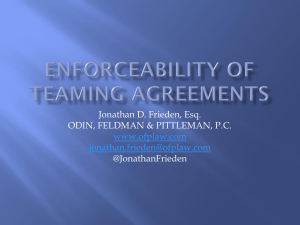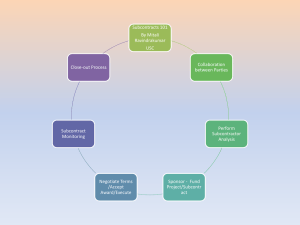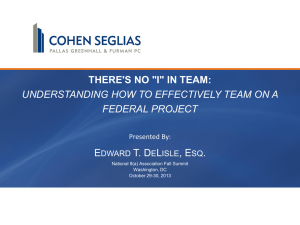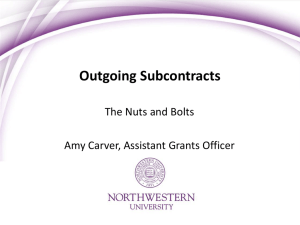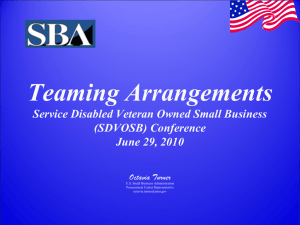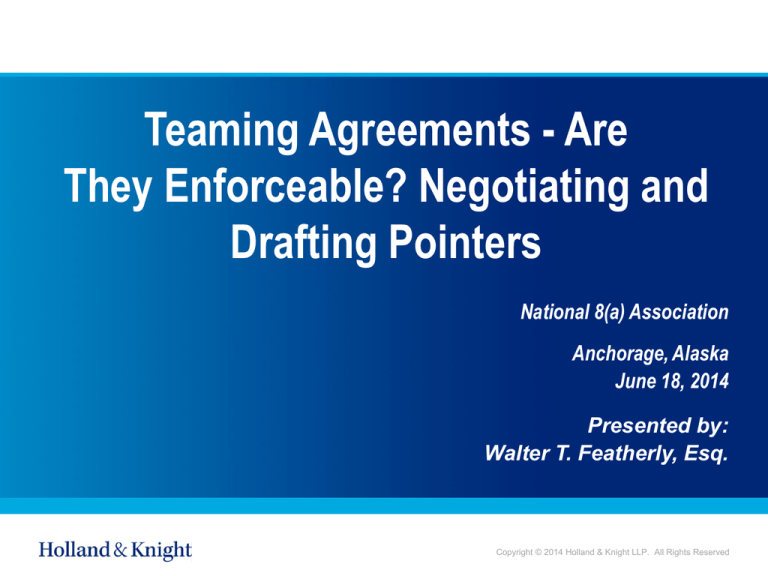
Teaming Agreements - Are
They Enforceable? Negotiating and
Drafting Pointers
National 8(a) Association
Anchorage, Alaska
June 18, 2014
Presented by:
Walter T. Featherly, Esq.
Copyright © 2014 Holland & Knight LLP. All Rights Reserved
Introduction
This session will:
• Review and analyze recent Cyberlock
Consulting v. Information Experts decision
(4th Cir. Va.).
• Compare Virginia legal standard to the legal
standard in Alaska regarding these issues.
• Provide pointers for negotiating and drafting
teaming agreements to be enforceable under
Alaska law.
2
Teaming Agreements - Definition
Teaming Agreement:
˗ Under the Federal Acquisition Regulation (FAR) 9.601
“means an arrangement in which:
• (1) Two or more companies form a partnership or joint
venture to act as a potential prime contractor;
or
• (2) A potential prime contractor agrees with one or
more other companies to have them act as its
subcontractors under a specified Government
contract or acquisition program.”
˗ The agreement by which parties pursue work, and that
will lead to a performance agreement (subcontract, JV,
etc.) if successful.
3
Teaming Agreements
• Teaming agreements are very
tricky.
• If the agreement is not carefully
drafted, it is very easy for
˗ the parties to agree to less or to more
than they intend or expect.
˗ the agreement’s terms to be
unenforceable.
4
Cyberlock Consulting
v.
Information Experts
Analysis and Implications
5
Cyberlock Consulting v. Information Experts
Cyberlock Consulting and Information Experts
executed a Second Teaming Agreement to seek out
a contract with the Office of Public Management.
• Second Teaming Agreement Purposes:
˗ To set forth the arrangement between
Information Experts and Cyberlock to obtain
an Information Experts’ prime contract.
˗ To set forth the basis for a subcontract
between Information Experts and Cyberlock.
6
Cyberlock Consulting v.
Information Experts (cont’d)
•
Each party will exert reasonable efforts to obtain an
Information Experts’ prime contract and negotiate a
subcontract between the parties.
˗ Work performance:
• Information Experts performs 51%; Cyberlock
performs 49% (as subcontractor).
˗ Information Experts had the responsibility to "exert
reasonable efforts to obtain Client approval for the
proposed Subcontractor for the Program."
˗ Agreement terminates if the parties fail to reach
agreement on a subcontract after a reasonable period
of good faith negotiations.
7
Cyberlock Consulting v.
Information Experts (cont’d)
•
•
•
Information Experts was awarded the prime contract, but did
not execute a subcontract with Cyberlock at that time.
The parties negotiated a subcontract for about a month until
Information Experts concluded the negotiations due to
continuing differences between the parties regarding the
terms of the proposed subcontract.
Cyberlock brought claims for fraud (dismissed), unjust
enrichment, and breach of contract.
˗
˗
Information Experts moved for summary judgment on
Cyberlock's breach of contract and unjust enrichment claims.
Cyberlock moved for partial summary judgment on its breach of
contract claim.
8
Cyberlock Consulting v.
Information Experts (cont’d)
The Court granted Information Experts’
Motion for Summary Judgment, denied
Cyberlock's Motion for Partial Summary
Judgment, and granted Information Experts’
Motion to Strike.
• The post-prime contract award obligations
in the Second Teaming Agreement are
unambiguous and constitute an
unenforceable agreement to agree.
9
Cyberlock Consulting v.
Information Experts (cont’d)
•
Numerous terms in the Second Teaming Agreement demonstrate
that:
˗
(1) the parties contemplated that a future, formal subcontract
would have to be negotiated and potentially executed; and
˗
(2) that they contemplated the possibility that the future
transaction discussed therein might not ever come to fruition.
•
The reference to the execution of a future subcontract could be read
to indicate that the Second Teaming Agreement was not meant to
function as the actual binding subcontract since the parties intended
a formal subcontract to be drawn up.
•
The agreement expressly acknowledged the possibility that
subcontract negotiations would fail, causing the agreement to
terminate.
10
Cyberlock & Alaska Law
A Comparison of the
Virginia Court Ruling
with Alaska Law
11
Legal Standard Applied in Cyberlock
Virginia Law:
• For a contract to be enforceable, “there must be mutual assent of
the contracting parties to terms reasonably certain under the
circumstances."
˗ Teaming Agreements are not special arrangements under
Virginia law, and as such are held to the same standard to
find mutual assent.
• The elements for a breach of contract claim are:
˗ (1) a legally enforceable obligation of a defendant to a
plaintiff;
˗ (2) the defendant's violation or breach of the obligation; and
˗ (3) an injury or harm to the plaintiff caused by the
defendant's breach.
12
Legal Standard Applied in Cyberlock (cont’d)
Virginia Law:
• Agreements to agree in the future are too vague and too
indefinite to be enforced.
˗ Any writing in which the terms of a future transaction
are left to be set out in a more formal agreement is
presumed to be an agreement to agree rather than a
binding contract.
˗ Agreements to negotiate at some point in the future are
unenforceable.
˗ An agreement to negotiate open issues in good faith to
reach a contractual objective will be construed as an
agreement to agree, not a valid contract.
13
Legal Standard Applied in Cyberlock (cont’d)
Virginia Law:
• Calling an agreement something other than a contract or
subcontract, such as a teaming agreement or letter of
intent, implies that the parties intend it to be a nonbinding
expression in contemplation of a future contract.
• The parties’ intention for a formal contract to be drawn up
is strong evidence that they did not intend the previous
negotiations to amount to a binding agreement.
• The central principal underlying the Cyberlock decision,
that an “agreement to agree in the future” is
unenforceable, is mirrored in Alaska case law.
14
Cyberlock Outcome & Alaska Law
Alaska law:
• Alaska law does not specifically address enforceability
of teaming agreements.
• Create a valid & enforceable contract.
• A valid contract requires:
˗ (1) an offer encompassing all essential terms,
˗ (2) unequivocal acceptance by the offeree,
˗ (3) consideration, and
˗ (4) an intent to be bound.
• An agreement is unenforceable if its terms are not
reasonably certain.
15
Cyberlock Outcome & Alaska Law (cont’d)
Alaska law:
•
Agreements to negotiate are unenforceable because they do not provide a
basis for determining whether a breach has occurred or basis for a remedy.
•
The hallmark of negotiation is bargaining.
•
˗
The parties ultimately may be unable to resolve their dispute without
outside help from the courts or ADR.
˗
Without agreeing on a more specific way of resolving their differences,
any agreement to negotiate is too indefinite to enforce.
An agreement to negotiate is not an agreement to agree.
˗
In theory, an agreement to negotiate is an enforceable contract.
˗
Parties who have merely agreed to negotiate have retained the ability to
say “no” to the terms proposed by the other party.
˗
But a court can never enforce an agreement to negotiate so as to bind
one party to the ultimate agreement that the parties sought, but failed to
negotiate.
16
Post Cyberlock
Teaming Agreements
Negotiating and Drafting
Enforceable Teaming Agreements
Under Alaska Law
17
Negotiation & Drafting:
Key Issues
18
Key Issues to Consider
•
Remember the purpose of the Teaming Agreement:
• To define how the parties will pursue prime contracts
together.
• To provide a commitment for what will happen if they
are awarded the prime contract.
• Title the Teaming Agreement a “Teaming Contract.”
– The term “agreement” indicates the document is
NOT a “contract.”
– The FAR’s definition of “contract” does not include
“agreement” and FAR 16.702(a)(2) and 16.703(a)(3)
state that agreements are not contracts.
19
Key Issues to Consider (cont’d)
•
•
•
Define the opportunity(ies) being pursued.
Define the obligations in proposal preparation.
˗ Discussions with the government.
Address how the parties will be referenced in the proposal to the
government.
˗ Addressed by name.
˗ Spell out their respective scopes of work (for subs, vital to be
referenced by name and have role spelled out).
˗ Include terms requiring cooperation to obtain government
approval of team members.
• Good pre-teaming due diligence is vital to avoid approval
problems.
20
Key Issues to Consider (cont’d)
Exclusivity:
•
•
•
•
•
A key element for both the proposal and contract
performance.
Sample language: “The parties agree to team on an
exclusive basis for the purpose of competing for the award
and performing the Prime Contract resulting from the RFP.”
What else can parties do regarding the “opportunity”?
Important to have defined the “opportunity” as precisely as
possible – be wary of broad definitions, particularly if they
speak to a “customer” as opposed to a particular
requirement.
For what period of time does the exclusivity apply post
termination?
21
Key Issues to Consider (cont’d)
Termination: When does the teaming arrangement end?
•
Typically,
˗
When solicitation is cancelled.
˗
When award is made to another party.
•
˗
When award is made to the team.
•
˗
Who decides whether to protest?
Teaming Agreement is then replaced by a subcontract or JV
agreement.
PERHAPS, upon notice by either party, but likely want to spell out
consequences.
•
Can the parties still pursue the opportunity in other ways?
•
Consider time frames (e.g., no termination within XX days of
proposal submission).
•
AND keep in mind, a unilateral right to terminate may undermine the
“agreement.”
22
Key Issues to Consider (cont’d)
Other Key Issues Include:
• Protection of proprietary and confidential
information.
• Will intellectual property be contributed to,
or developed in, the course of the
relationship?
• Non-solicitation of employees.
• Dispute resolution provisions.
23
Negotiation & Drafting:
Pointers & Checklists
Prime Contractors
Subcontractors
Joint Venture Partners
24
Prime Contractors
•
•
•
A teaming agreement must contain sufficiently definite terms to
be enforceable.
Purpose: Clearly indicate a two-fold objective
˗ For the parties to work collaboratively in the preparation,
drafting and submission of a proposal that is responsive to
the RFP; and
˗ For the parties to perform the contract, with one party acting
as the Prime Contractor and the other party as its
Subcontractor.
Avoid terms that undermine the “agreement.”
˗ “Neither party is bound until execution of a subcontract.”
˗ “This agreement is subject to the parties negotiating
acceptable subcontract terms.”
25
Prime Contractors (cont’d)
•
•
Avoid provisions that create a partnership or other
relationship among the parties, binding the parties
to one another in ways they neither intended nor
expected.
Caution: Watch out for “Affiliation” under the SBA
small business regulations.
˗ A teaming agreement may result in the teaming
partners being considered affiliates, that could
make one or both ineligible for the procurement
opportunity.
26
Prime Contractors (cont’d)
•
“Good Faith and Fair Dealing” & “Best Efforts”
˗ Necessary terms for future negotiations of any
terms not already agreed to in Teaming
Contract.
˗ Define terms in Teaming Contract.
˗ Couple with specific timeline to reach
agreement.
˗ Specify that failure to reach final agreement
under definition and timeline shall be resolved
via arbitration.
27
Subcontractors
• Under the Worker’s Compensation statutes
of many states, a subcontractor is defined as
“a person to whom a contractor sublets all or
part of the initial undertaking” (a person can
be an entity as well as a natural person).
28
Subcontractors (cont’d)
˗
˗
˗
Include language in “objectives” provision stating that
the subcontract is for the performance of specific work.
• Include a “Scope of Work” description as an
attachment, with pricing.
Describe subcontractor’s rights to participate in the
teaming contract.
Describe subcontractor’s rights to participate in contract
performance via subcontract.
• State at the outset of the Teaming Contract that it is
the intent of the parties that the Prime Contractor will
award a subcontract to the Subcontractor.
29
Subcontractors (cont’d)
˗
Exclusivity is a key element.
• i.e., “the parties agree to team on an
exclusive basis for the purpose of competing
for the award and performing the Prime
Contract resulting from the RFP.”
• Include exclusivity language for proposal and
contract performance.
˗ Require prime contractor to fully identify
subcontractor in communications with awarding
agency.
30
Subcontractors (cont’d)
•
•
Pre-negotiate all essential subcontract terms to be adopted upon
award of prime contract and subsequent execution of
subcontract.
˗ Especially Scope of Work & Pricing.
˗ Any changes to pre-negotiated terms must be by mutual
agreement.
Include provision that parties will enter into good faith and fair
dealing discussions to finalize the wording of the terms and
conditions of the Subcontract so that they are consistent with the
proposal submitted to the Government, and include “flow-down”
terms and conditions and FAR clauses.
˗ Incorporate standard terms and conditions and FAR clauses
by reference.
31
Subcontractors (cont’d)
•
•
Avoid references to a future subcontract to be
entered into by the parties:
˗ Courts read this to mean that the agreement is
not meant to function as a binding contract
since the parties intended a formal subcontract
to be executed later.
Termination:
˗ Avoid any terms acknowledging possibility that
subcontract negotiations would fail, causing
the agreement to terminate.
32
Joint Venture Partners
•
•
A Joint Venture, as defined in the FAR (Section
19.101(7)), is an association:
˗ of persons or concerns
˗ with interests in any degree or proportion
˗ by way of contract, express or implied
˗ consorting to engage in and carry out a single
specific business venture for joint profit
˗ for which purpose they combine their efforts,
property, money, skill, or knowledge
˗ but not on a continuing or permanent basis for
conducting business generally
Note: The FAR definition of a joint venture fits the
definition of a “partnership” under the Uniform
Partnership Act.
33
Joint Venture Partners (cont’d)
•
•
A greater level of knowledge and trust is required for
joint venture relationships. As such, a greater level of
scrutiny is required in negotiating and drafting
Teaming Contracts for joint ventures.
Teaming Contract for Joint Venture Partners should
incorporate:
˗ each of the provisions discussed above regarding
subcontractors, AND
˗ each of the additional SBA regulations unique to
Joint Venture Partnerships.
34
Joint Venture Partners, SBA Considerations
Include a provision addressing affiliation between the
Teaming Contract parties.
• Are the parties affiliated?
• How does this impact their eligibility for the
contract?
• Affiliation rules. Joint ventures create affiliation,
except:
˗ Between two small businesses for certain
larger contracts, and
˗ Between mentors and protégés approved by
the SBA.
35
Joint Venture Partners, SBA Considerations (cont’d)
Include a provision addressing affiliation between the Teaming
Contract parties.
• In general, prime and sub are not affiliates, but
˗ The “Ostensible subcontractor” rule (previously discussed).
• An ostensible subcontractor is a subcontractor that
performs primary and vital requirements of a contract or
a subcontractor upon which the prime contractor is
unusually reliant, causing the parties to be treated as
joint venturers and affiliates for size determination
purposes. 13 CFR 121.103(h)(4).
˗ Remember that the “Self performance” rule applies to all set
aside procurements.
36
Joint Venture Partners, SBA Considerations (cont’d)
Identify and agree to work performance requirements:
• For an unpopulated joint venture, or a joint venture
populated only with one or more administrative
personnel, the 8(a) partner must perform at least 40% of
the work (more than administrative or ministerial
functions). 13 CFR 124.513(d).
• In an unpopulated joint venture where both the 8(a) and
non-8(a) partners are technically subcontractors, the
amount of work done by the partners will be aggregated
and the work done by the 8(a) partner must be at least
40% of the total done by all partners. 13 CFR
124.513(d)(2)(i).
37
Joint Venture Partners, SBA Considerations (cont’d)
• For a joint venture populated with individuals
intended to perform contracts awarded to the
joint venture, each 8(a) participant to the joint
venture must demonstrate what it will gain
from performance of the contract and how
such performance will assist in its business
development. 13 CFR 124.513(d).
38
References:
Case Law
Cyberlock Consulting, Inc. v. Information Experts, Inc., 939 F.
Supp. 2d 572 (E.D. Va. 2013)
Davis v. Dykman, 938 P.2d 1002, 1006 (Alaska 1997)
Fernandez v. Fernandez, 312 P.3d 1098, 1104 (Alaska 2013)
Valdez Fisheries Dev. Ass 'n Inc. v. Alyeska Pipeline Serv. Co.,
45 P.3d 657, 667 (Alaska 2002)
Schultz v. Travelers Indem. Co., 754 P.2d 265 (Alaska 1988)
Regulatory
FAR 16.702-703
FAR 9.601
FAR 52.219-14
13 CFR 121
13 CFR 124
13 CFR 125
39
Questions or Comments?
Thank you for attending. If you have any questions or
comments about today’s session, please feel free to
contact:
Walter T. Featherly
(907) 263-6395
Walter.Featherly@hklaw.com
40
Thank You!
www.hklaw.com

